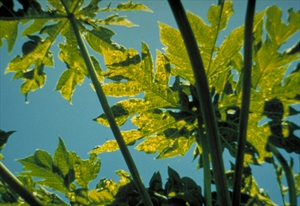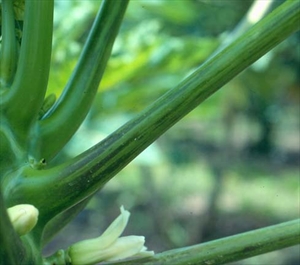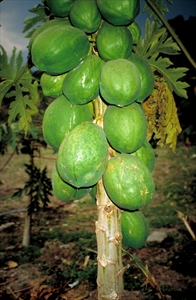Papaya ringspot (virus-P)
Pacific Pests, Pathogens, Weeds & Pesticides - Online edition
Pacific Pests, Pathogens, Weeds & Pesticides
Papaya ringspot (virus-P) (194)
Papaya ringspot potyvirus-P. The abbreviation for this virus is PRSV. There is another strain of this virus called Papaya ringspot virus-W. These two strains are very similar, except that type PRSV-W does not infect papaya; it infects cucurbits. Previously, the strain infesting cucurbits was known as Watermelon mosaic virus-1.
Asia, Africa, North, South and Central America, the Caribbean, Europe, Oceania. PRSV-P is recorded from Guam, French Polynesia and Northern Mariana Islands. It has been eradicated from Cook Islands.
PRSV-P infects papaya and cucurbits (cucumber, melons, pumpkin, squash and zucchini). PRSV-W infects cucurbits only.
Leaves become mottled with intense yellow and green patterns (known as mosaics) (Photo 1); they are also distorted and much smaller than normal. Older leaves show dark green streaks on the leaf stalks (Photo 2). Characteristic ringspots develop on the fruits (Photo 3). Plants may be stunted with fewer fruits than normal, but they rarely die from infection. The disease affects the flavour of the fruit.
Spread of the disease occurs in two ways. First, infected plants are moved from nurseries to plantations, and this can spread the disease short and long distances; secondly, aphids spread the virus from infected papaya trees to healthy ones. Spread of the disease on or in seed has not been shown to be important in the spread of PRSV-P.
There are many species of aphids that spread PRSV-P naturally, although some species are more efficient than others. In the Pacific islands, the aphid, Aphis gossypii, is common and transmits the virus in a non-persistent way; this means that it acquires the virus on its mouth parts after a short feed on an infected plant (less than a minute), infects a healthy plant after another short feed, and then loses the ability to infect.
Papaya is not the preferred host for aphids; they feed on it, move on, feed again, and in the process spread the virus very quickly.
Once the virus is established in a new planting, all the trees will be infected by tree-to-tree spread within 3-7 months. Spread is very rapid by aphids.
Cucurbits, which are alternative hosts of the virus, are not considered important in the transfer of the virus to papaya, nor are weeds.
PRSV-P is a major disease of papaya, and has had a devastating impact on papaya production in Brazil, Hawaii, the Philippines and Taiwan until resistant varieties became available. Trees infected early may never produce any marketable fruit, and infection of mature trees invariably results in yield decline. Even if fruit reach maturity, the appearance of ring spots on the fruit reduce market acceptability, and flavour is poor.
In some countries, the industry has moved to disease-free areas to try to keep ahead of the virus. This has happened in Brazil and Hawaii, but experience has shown that PRSV-P eventually catches up.
Look for the mosaic patterns of yellow and green on the leaves, and the characteristic ringspots on the fruits.
QUARANTINE
Papaya ringspot potyvirus - type P is a major disease, and one that is difficult to control. Countries where the virus is not yet present should make sure that they have the controls in place to prevent its entry. The uncontrolled entry of seedlings or seed from uncertified sources should be prohibited.
CULTURAL CONTROL
- Remove any volunteer papaya from within and also around papaya plantings.
- Restrict movement of people within the plantation. Aphids can be taken into plantations on people's clothes.
- Remove (i) diseased trees as soon as symptoms are seen, and also (ii) severely affected blocks of papaya trees. The reason for doing this is that infected plantations are unlikely to produce an acceptable crop of fruit, but they are likely to be sources of the virus, and aphids which will spread the disease. Unfortunately, it is difficult to control PRSV this way as the spread by aphids is so fast.
- Grow papaya under netting. This is very expensive and not a method for small-scale producers and subsistence growers.
RESISTANT VARIETIES
Several methods have been used to produce resistant plants: (i) mild strain infection of plants which protects them from more serious virus strains; (ii) resistant varieties bred using conventional methods; (iii) resistant varieties produced by genetic modification, i.e., the insertion of the virus coat protein gene into the papaya DNA.
CHEMICAL CONTROL
Chemical control is not effective against this disease because aphids are able to transmit the virus so quickly. Even though insecticides may kill the aphids, usually it is too late: by the time the insecticide kills the aphid, it has fed and transmitted the virus.
AUTHOR Grahame Jackson
Information from Davis RI, Ruabete TK (2010) Records of plant pathogenic viruses and virus-like agents from 22 Pacific island countries and territories: a review and an update. Australasian Plant Pathology 39, 265-291; and CABI (2018) Papaya ringspot virus. Crop Protection Compendium. (https://www.cabi.org/cpc/datasheet/45962); and DAF (2020) Papaya ringspot disease. Business Queensland. Queensland Government; and from Gonsalves DS, et al. (2010) Papaya ringspot virus. The Plant Health Instructor. The American Phytopathological Society.(https://www.apsnet.org/edcenter/disandpath/viral/pdlessons/Pages/PapayaRingspotvirus.aspx). Photo 1 George Wall, formerly CALS/AES University of Guam. Photo 2 Department of Employment, Economic Development and Innovation, Queensland.
Produced with support from the Australian Centre for International Agricultural Research under project PC/2010/090: Strengthening integrated crop management research in the Pacific Islands in support of sustainable intensification of high-value crop production, implemented by the University of Queensland and the Secretariat of the Pacific Community.






